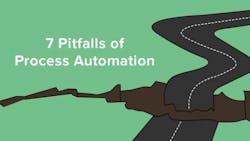7 Pitfalls of Process Automation to Avoid at All Costs
In recent years, many businesses have lived by the notion ‘automate or die’ when it comes to their processes. With the growing ease of business process automation software, many companies and consultants feel their job is not done until every inch of the office is covered with automation.
BPA software has undoubtedly helped companies cut down costs and improve efficiency. By minimizing human error and allowing systems to speak to each other, business process automation has given some significant improvements to the way business is done.
However, a blanket approach to automation can leave a trail of wreckage and a bitter taste for business owners. Automation is not a one-size-fits-all solution to fix business problems, and when applied to every situation, it can create more problems than it solves.
Shockingly, some processes can even run better when freed from restrictive business process automation software. Productivity can suffer when processes are subjected to improper automation, thereby negating any perceived benefit. And with the cost of most automation tools, these struggles are more than just an annoyance.
Here are seven pitfalls to watch out for when you are implementing automation.
1. Don’t Overspend
Process automation is designed to cut costs and time. So when the software you choose ends up costing more than it’s worth, only to result in employees trying to hack their way around the process, you know you have a big problem. This is when automation becomes a liability instead of an asset.
When companies spend big for a large automation initiative, they want to get their money’s worth and apply automation to as many processes as possible. However, when applied incorrectly, automation is going to hurt a company much more than it helps it.
2. Watch Out for Insufficient GainsA company’s reasonable expectation out of any business process automation initiative is to deliver results that surpass the previous manual processes. But many companies don’t gather the data to substantiate this claim. Anautomated process can give the feeling of speed only because it is digital, but if you are not getting the right results, or if you spend most of your time trying to fix the process, you’ve wasted your time and money.
Automation can take some time to show significant improvement as people get used to a new system. However, if you can’t demonstrate a clear time and efficiency advantage after a few months, you need to either make changes to your automated process, or consider going back to manual. The gains from any automation initiative should not only show in terms of improving efficiency, but also justify the cost it takes to implement the solution in the first place.
3. Don’t Let Dehumanization Kill Intelligence
In the customer service sector, automated voice service has become so ineffective that many customers will give up at the thought of going in circles and not finding a solution. One key is that most automated voice services don’t have any intelligence built in. They are merely a catalogue of resources searchable by voice. The system can’t deal with nuances or make quick adjustments. In many situations of dealing with customers, manual processes involving human interactions give a better experience.
The key lesson here is not to miss out on the opportunity to optimize workflow by draining out intelligence from a process. Automation trumps human errors, but some processes must have a bit of human inefficiency built into them to ensure that the final experience is positive. Processes can lack accountability when human intervention is out of the equation. Customers/partners might feel ignored if they are left at the mercy of going through an automated process.
PEX Process Excellence Network is a Lean Six Sigma certification courses provider.


